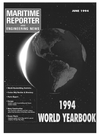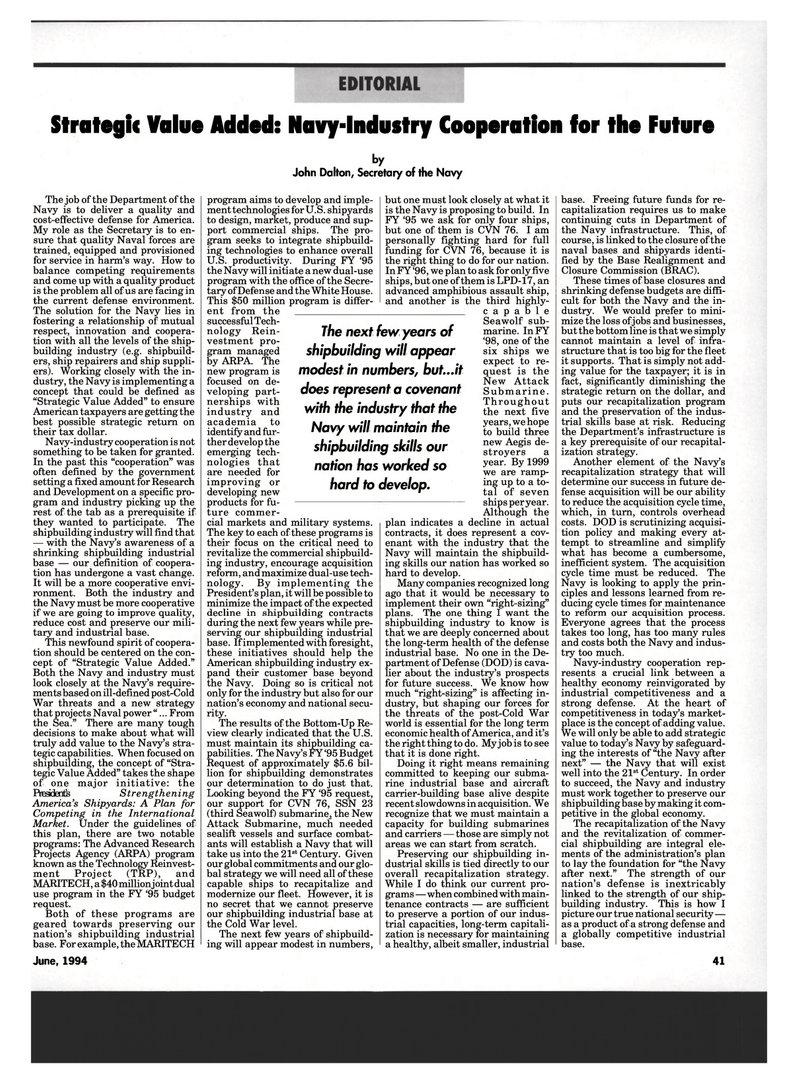
Page 35: of Maritime Reporter Magazine (June 1994)
Read this page in Pdf, Flash or Html5 edition of June 1994 Maritime Reporter Magazine
Strategic Value Added: Navy-Industry Cooperation for the Future by
John Dalton, Secretary of the Navy
The job of the Department of the
Navy is to deliver a quality and cost-effective defense for America.
My role as the Secretary is to en- sure that quality Naval forces are trained, equipped and provisioned for service in harm's way. How to balance competing requirements and come up with a quality product is the problem all of us are facing in the current defense environment.
The solution for the Navy lies in fostering a relationship of mutual respect, innovation and coopera- tion with all the levels of the ship- building industry (e.g. shipbuild- ers, ship repairers and ship suppli- ers). Working closely with the in- dustry, the Navy is implementing a concept that could be defined as "Strategic Value Added" to ensure
American taxpayers are getting the best possible strategic return on their tax dollar.
Navy-industry cooperation is not something to be taken for granted.
In the past this "cooperation" was often defined by the government setting a fixed amount for Research and Development on a specific pro- gram and industry picking up the rest of the tab as a prerequisite if they wanted to participate. The shipbuilding industry will find that — with the Navy's awareness of a shrinking shipbuilding industrial base — our definition of coopera- tion has undergone a vast change.
It will be a more cooperative envi- ronment. Both the industry and the Navy must be more cooperative if we are going to improve quality, reduce cost and preserve our mili- tary and industrial base.
This newfound spirit of coopera- tion should be centered on the con- cept of "Strategic Value Added."
Both the Navy and industry must look closely at the Navy's require- ments based on ill-defined post-Cold
War threats and a new strategy that projects Naval power "... From the Sea." There are many tough decisions to make about what will truly add value to the Navy's stra- tegic capabilities. When focused on shipbuilding, the concept of "Stra- tegic Value Added" takes the shape of one major initiative: the
Ptesidenfe Strengthening
America's Shipyards: A Plan for
Competing in the International
Market. Under the guidelines of this plan, there are two notable programs: The Advanced Research
Projects Agency (ARPA) program known as the Technology Reinvest- ment Project (TRP), and
MARITECH, a $40 million joint dual use program in the FY '95 budget request.
Both of these programs are geared towards preserving our nation's shipbuilding industrial base. For example, the MARITECH
June, 1994 program aims to develop and imple- ment technologies for U.S. shipyards to design, market, produce and sup- port commercial ships. The pro- gram seeks to integrate shipbuild- ing technologies to enhance overall
U.S. productivity. During FY '95 the Navy will initiate a new dual-use program with the office of the Secre- tary of Defense and the White House.
This $50 million program is differ- ent from the successful Tech- nology Rein- vestment pro- gram managed by ARPA. The new program is focused on de- veloping part- nerships with industry and academia to identify and fur- ther develop the emerging tech- nologies that are needed for improving or developing new products for fu- ture commer- cial markets and military systems.
The key to each of these programs is their focus on the critical need to revitalize the commercial shipbuild- ing industry, encourage acquisition reform, and maximize dual-use tech- nology. By implementing the
President's plan, it will be possible to minimize the impact of the expected decline in shipbuilding contracts during the next few years while pre- serving our shipbuilding industrial base. If implemented with foresight, these initiatives should help the
American shipbuilding industry ex- pand their customer base beyond the Navy. Doing so is critical not only for the industry but also for our nation's economy and national secu- rity.
The results of the Bottom-Up Re- view clearly indicated that the U.S. must maintain its shipbuilding ca- pabilities. The Navy's FY '95 Budget
Request of approximately $5.6 bil- lion for shipbuilding demonstrates our determination to do just that.
Looking beyond the FY '95 request, our support for CVN 76, SSN 23 (third Seawolf) submarine, the New
Attack Submarine, much needed sealift vessels and surface combat- ants will establish a Navy that will take us into the 21st Century. Given our global commitments and our glo- bal strategy we will need all of these capable ships to recapitalize and modernize our fleet. However, it is no secret that we cannot preserve our shipbuilding industrial base at the Cold War level.
The next few years of shipbuild- ing will appear modest in numbers,
The next few years of shipbuilding will appear modest in numbers, but..it does represent a covenant with the industry that the
Navy will maintain the shipbuilding skills our nation has worked so hard to develop. but one must look closely at what it is the Navy is proposing to build. In
FY '95 we ask for only four ships, but one of them is CVN 76. I am personally fighting hard for full funding for CVN 76, because it is the right thing to do for our nation.
In FY '96, we plan to ask for only five ships, but one of them is LPD-17, an advanced amphibious assault ship, and another is the third highly- capable
Seawolf sub- marine. In FY '98, one of the six ships we expect to re- quest is the
New Attack
Submarine.
Throughout the next five years, we hope to build three new Aegis de- stroyers a year. By 1999 we are ramp- ing up to a to- tal of seven ships peryear.
Although the plan indicates a decline in actual contracts, it does represent a cov- enant with the industry that the
Navy will maintain the shipbuild- ing skills our nation has worked so hard to develop.
Many companies recognized long ago that it would be necessary to implement their own "right-sizing" plans. The one thing I want the shipbuilding industry to know is that we are deeply concerned about the long-term health of the defense industrial base. No one in the De- partment of Defense (DOD) is cava- lier about the industry's prospects for future success. We know how much "right-sizing" is affecting in- dustry, but shaping our forces for the threats of the post-Cold War world is essential for the long term economic health of America, and it's the right thing to do. My job is to see that it is done right.
Doing it right means remaining committed to keeping our subma- rine industrial base and aircraft carrier-building base alive despite recent slowdowns in acquisition. We recognize that we must maintain a capacity for building submarines and carriers — those are simply not areas we can start from scratch.
Preserving our shipbuilding in- dustrial skills is tied directly to our overall recapitalization strategy.
While I do think our current pro- grams —when combined with main- tenance contracts — are sufficient to preserve a portion of our indus- trial capacities, long-term capitali- zation is necessary for maintaining a healthy, albeit smaller, industrial base. Freeing future funds for re- capitalization requires us to make continuing cuts in Department of the Navy infrastructure. This, of course, is linked to the closure of the naval bases and shipyards identi- fied by the Base Realignment and
Closure Commission (BRAC).
These times of base closures and shrinking defense budgets are diffi- cult for both the Navy and the in- dustry. We would prefer to mini- mize the loss of jobs and businesses, but the bottom line is that we simply cannot maintain a level of infra- structure that is too big for the fleet it supports. That is simply not add- ing value for the taxpayer; it is in fact, significantly diminishing the strategic return on the dollar, and puts our recapitalization program and the preservation of the indus- trial skills base at risk. Reducing the Department's infrastructure is a key prerequisite of our recapital- ization strategy.
Another element of the Navy's recapitalization strategy that will determine our success in future de- fense acquisition will be our ability to reduce the acquisition cycle time, which, in turn, controls overhead costs. DOD is scrutinizing acquisi- tion policy and making every at- tempt to streamline and simplify what has become a cumbersome, inefficient system. The acquisition cycle time must be reduced. The
Navy is looking to apply the prin- ciples and lessons learned from re- ducing cycle times for maintenance to reform our acquisition process.
Everyone agrees that the process takes too long, has too many rules and costs both the Navy and indus- try too much.
Navy-industry cooperation rep- resents a crucial link between a healthy economy reinvigorated by industrial competitiveness and a strong defense. At the heart of competitiveness in today's market- place is the concept of adding value.
We will only be able to add strategic value to today's Navy by safeguard- ing the interests of "the Navy after next" — the Navy that will exist well into the 21st Century. In order to succeed, the Navy and industry must work together to preserve our shipbuilding base by making it com- petitive in the global economy.
The recapitalization of the Navy and the revitalization of commer- cial shipbuilding are integral ele- ments of the administration's plan to lay the foundation for "the Navy after next." The strength of our nation's defense is inextricably linked to the strength of our ship- building industry. This is how I picture our true national security — as a product of a strong defense and a globally competitive industrial base. 41

 34
34

 36
36
